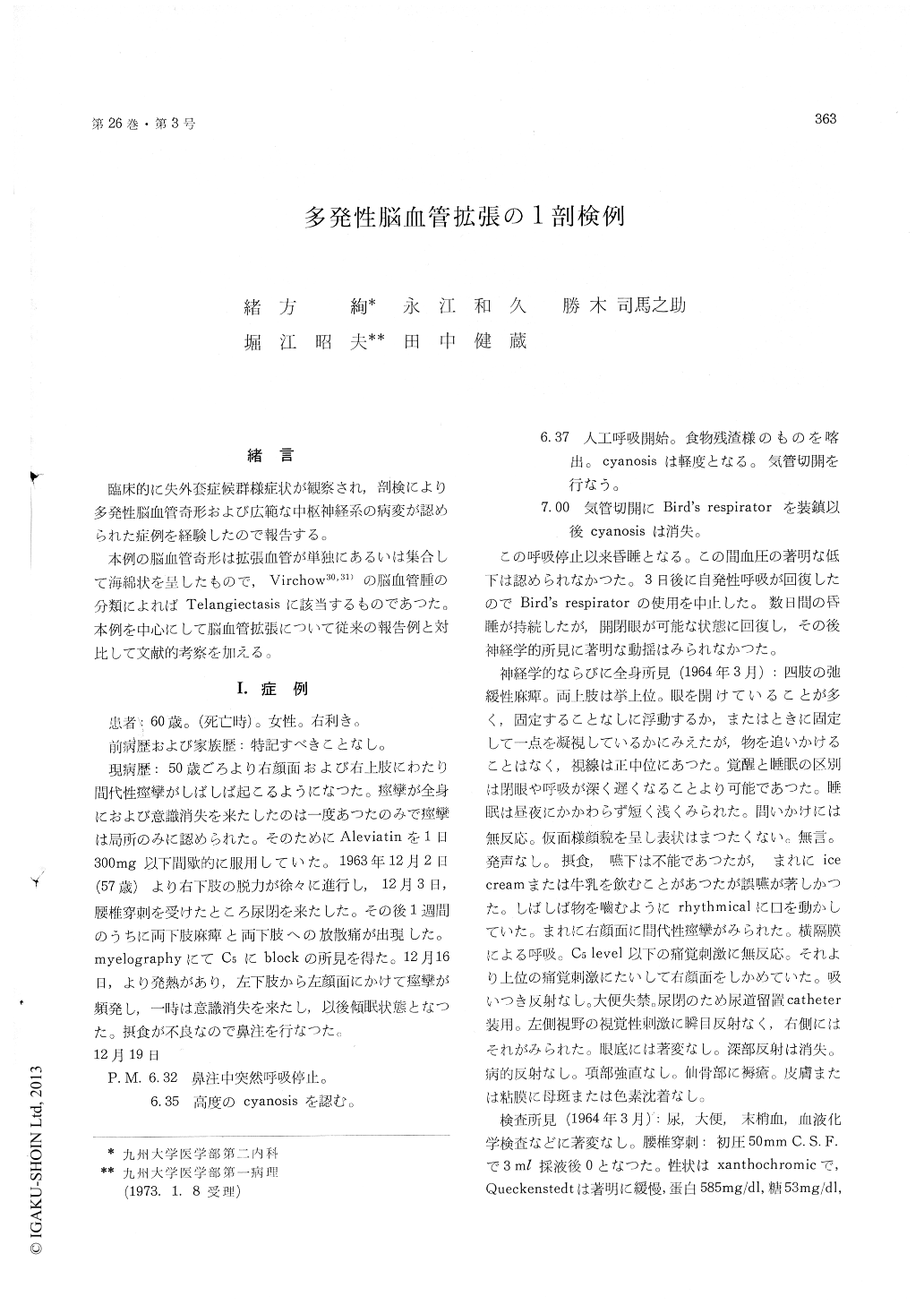Japanese
English
- 有料閲覧
- Abstract 文献概要
- 1ページ目 Look Inside
緒言
臨床的に失外套症候群様症状が観察され,剖検により多発性脳血管奇形および広範な中枢神経系の病変が認められた症例を経験したので報告する。
本例の脳血管奇形は拡張血管が単独にあるいは集合して海綿状を呈したもので,Virchow30,31)の脳血管腫の分類によればTelangiectasisに該当するものであつた。木例を中心にして脳血管拡張について従来の報告例と対比して文献的考察を加える。
An autopsy case of multiple telangiectases of the brain in a 60 year-old female was presented. Clinical history: A right-handed female began to have focal seizures on the right side of the face and the right upper limb since 50 years of age. At age 57, patient developed weakness of the left lower limb, followed by paraplegia and impairment of consciousness one week later. Sudden respiratory arrest occurred during tube feeding, followed by loss of consciousness. Patient was resucitated in 5 minutes. Patient had been put on Bird's respirator through tracheotomy for 2 days. Several days later, when she recovered consciousness, she was found to show the following neurological findings. She was quadriplegic, mute and completely unre-sponsive to any external stimuli except for grimacing the right half of the face to nociceptive stimuli over the right side of the face and neck above Cs level. The eyes were constantly floating and occasionally appeared to stare at the ceiling. These findings remained stationary over a period of 2 years and 7 months until the death at age 60. General postmortem findings: Multiple cavernous hemangioma of the adrenal glands, left ovary and spleen.
Gross neuropathological findings: Brain weight; 840 g. Atrophy of the right cerebral hemisphere. Over 90 brown nodules of various sizes in the cerebrum, cerebellum and pons on sectioning. Infarct of the lower cervical cord.
Microscopic neuropathological findings : The nod-ules were made up of dilated blood spaces of various diameters. The walls consisted of dense collagen lined with endothelium which were devoid of muscle or elastic fibers. Some of them were closely packed together with little inter-vascular spaces, while the others were separated by brain tissue. There were mural dissection and thrombosis in some of the dilated blood spaces. The cortex of the right cerebral hemisphere was almost completely devoid of nerve cells, except for preserved cytoarchitecture in its medial and basal aspects. There were severe degeneration of the centrum semiovale on the right, and slight to moderate on the left. There was severe loss of Purkinje cells. The spinal cord infarct contained occluded vascular malformation with calcification.
Discussion: The vascular malformation of this case can be categorized to the transitional form between cavernous angioma and telangiectasis according to Virchow. This case is characterized by the remarkable multiplicity of the vascular malformation in the whole central nervous system, inclusive of the spinal cord where the vascular malformation is considered to have induced infarc-tion by its secondary alteration. The prompt occurrence of the severe neurological deficits fol-lowing the respiratory arrest indicates that the anoxic hypoxia has a causal relationship to the cerebral hemiatrophy. Literatures show a decrease of cerebral blood flow of the neighboring or remote cerebral areas connected to arteriovenous malfor-mation by shunting between the arterial and venous circulatory system. It might be logical to assume that such shunting, even if small in quantity, exists in the vascular malformation of this case. Such focal silent vascular insufficiency, which possibly existed in this case prior to the catastrophe, could be attributed to the asymmetri-cal hypoxic damage of the cerebral hemisphere. The term, "Apallisches Syndrom" by Kretschmer, could be applied to describe the neurological status following the respiratory arrest.

Copyright © 1974, Igaku-Shoin Ltd. All rights reserved.


